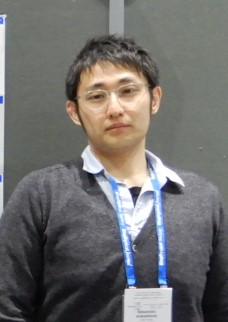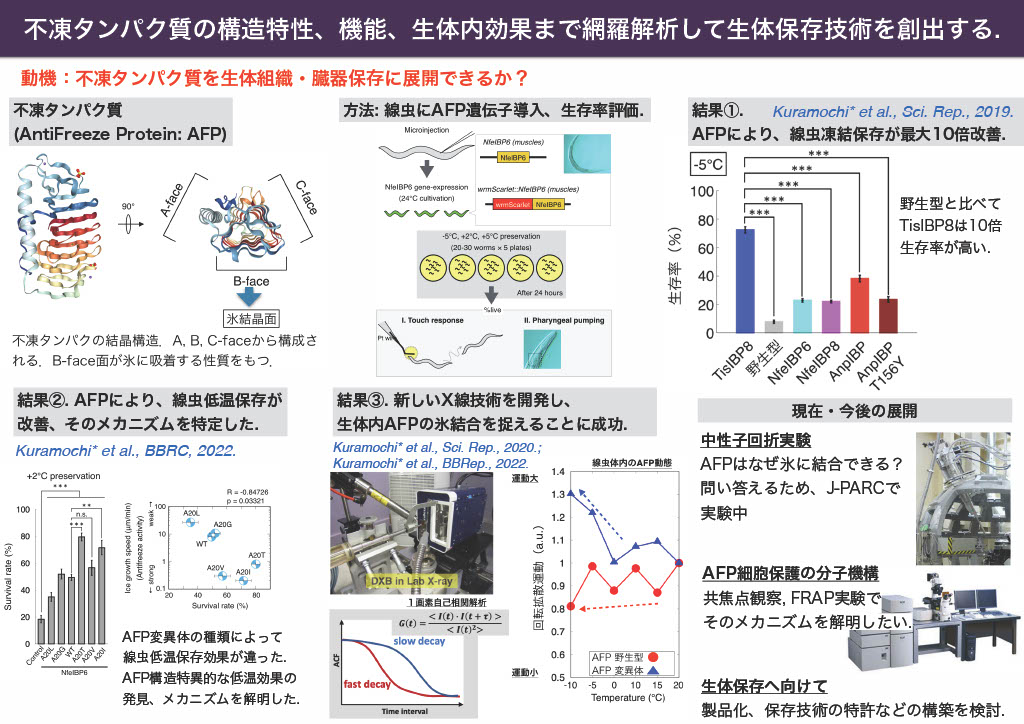Strategic Professional Development Program for Young Researchers
Top Runner Development Program Engaging Universities,
National Labs, and Companies
Fellows (1st-term)

KURAMOCHI, Masahiro
Assistant Professor
Graduate School of Science and Engineering
Ibaraki University
- Research fields
- Biophysics
- Research project
- Functional analysis of the ice-binding proteins and their application to bio-preservation technology
- Keywords
- Ice-binding Protein, C. elegans, X-ray, Structural Dynamics
- Researchers Information
- https://info.ibaraki.ac.jp/Profiles/120/0011922/profile.html
- researchmap
- https://researchmap.jp/masahiro_kuramochi
Biography
04/2005 – 03/2009 College of Engineering, Ibaraki University
04/2009 – 03/2011 Graduate School of Science and Engineering, Ibaraki University
04/2011 – 08/2013 Hardy Co., Ltd.
09/2013 – 03/2014 Biomedical R.I., AIST
04/2014 – 03/2017 Graduate School of Life and Environmental Sciences, University of Tsukuba
04/2016 – 03/2017 JSPS Research Fellowships for Young Scientists DC2
04/2017 – 04/2021 Graduate School of Frontier Sciences, The University of Tokyo
05/2021 – present Graduate School of Science and Engineering (Engineering), Ibaraki University
Research Outline

Ice-binding proteins (IBPs) are capable of binding ice crystals and inhibiting their growth. This unique function is useful for protecting freeze damage and long-term cryopreservation. Hence, IBPs have attracted attention not only in the food industry but also in the industrial, medical and drug discovery fields. In particular, the application of cell and tissue preservation techniques using IBPs is expected in the medical-related field. To this end, it is important to seek for the most suitable IBP molecules and analyse their performance. Experimental validation at the level of individual organisms would provide useful information.
Here, I characterized the relationship between the IBP effects and the physiological role by using the nematode Caenorhabditis elegans. The expression of fish- and fungus-derived IBPs in C. elegans improved its survival rate during exposure to freezing temperature. In addition, dynamic motions of IBPs were analysed in living C. elegans using the diffracted X-ray blinking (DXB) technique. I succeeded to monitor the dynamical behaviour of IBPs at freezing temperature. Recently, I also found that IBPs improve the survival rate at unfrozen low temperatures.
Currently, by using the cutting-edge techniques such as neutron diffraction, DXB and fluorescence observation, I aim to understand the structure-specific function and the cytoprotective mechanisms in IBPs.
What is my goal as a transborder researcher?
急速な社会情勢の変化、顕在化された様々な課題に直面し、科学技術に求められる役割も大きく変わりつつあります。時代のニーズにフィットしつつ、「研究」に主軸をおいた研究体制を構築する必要があります。TRiSTARフェローとして、専門力深化、俯瞰力、マネジメント力を深化させ、世界を牽引するサイエンスを展開し、異分野融合による学理創生、産業界も巻き込んだ社会実装を目指します。
Faced with rapidly changing social conditions and a variety of emerging challenges, the role required of science and technology is dramatically changing. It is necessary to build a research system that fits the needs of the times, while at the same time focusing on "research". As the TRiSTAR fellow, I improve my advanced expertise, overlooking and management skills. I also aim to become world-leading researcher by conducting multidisciplinary and social implementation research involving industry.
Movies
-
KURAMOCHI, Masahiro, TRiSTAR Fellow (1st-term)
Related article
In Preparation.
